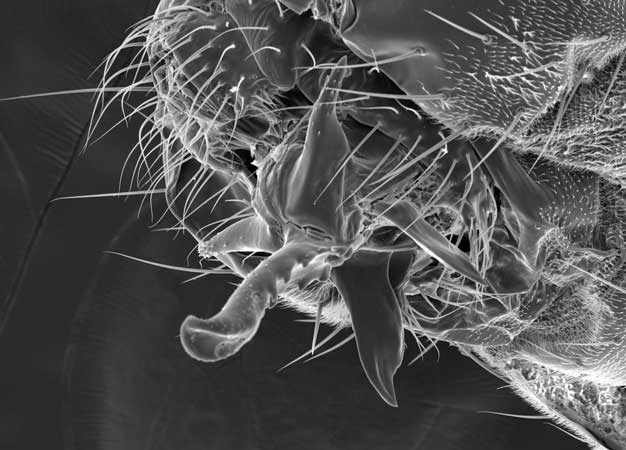The reproductive tracts of female fruit flies have evolved to minimize damage caused by mating
Published online 24 November 2016

Male West African fruit flies (Drosophila erecta) have pointed genitalia (pictured), which females have evolved to accommodate.
© 2016 Yoshitaka Kamimura, Keio University
Pity the poor female fruit fly. When she mates, the male inserts his pointy genital organ into her reproductive tract, where it opens like an anchoring device, inflicting what are known as copulatory wounds.
However, a new study by Yoshitaka Kamimura shows that female flies have developed an adaptation that protects them from this traumatic penetration1. The female genitalia have evolved soft pouches that ensure the resulting damage does not interfere with reproductive success.
"This sexual conflict over mating is likely to be the major evolutionary force underlying the observed genital coevolution," says Kamimura, an entomologist and evolutionary biologist at Keio University. While most scholars of sexual conflicts in the animal kingdom have focused on male adaptations, Kamimura's study demonstrates that the evolution of female genitalia can be just as complex.
Kamimura had previously found that the females of several species of fruit flies and other insects have copulatory wounds after mating. However, in the West African fruit fly, Drosophila erecta, it seemed the female genital tract had evolved to limit these injuries, but it wasn't clear how. Did their soft pouches serve a protective function? Or was it the nearby hardened shields that mitigated the harmful effects of mating?
To better understand the evolutionary forces shaping female genitalia, Kamimura artificially damaged each structure and examined how it affected reproductive output. With each female fly, he anesthetized the insect and gently pushed aside the tips of the abdomen to reveal the internal structures of the reproductive tract. He then punctured the genital tract in one of three sites: the pouch, the shield, or the plate above the ovipositor tube through which the female lays her eggs. "The pouches were especially difficult to manipulate because they are colorless, tiny, and inconspicuous," Kamimura says.
Kamimura didn't use special equipment ― only forceps, pins, scalpels, glass slides, sticky tape, and a microscope. "What I needed," he says, "was just practice, practice, and practice."
The flies generally survived the surgery but subsequent reproductive success depended on the site of the damage. Injury to the vaginal shield resulted in fewer eggs being successfully laid, and a harmed ovipositor plate led to lower rates of successful insemination. Wounding the pouch had little effect on mating and egg-laying success, suggesting that the soft structures evolved to help direct the spiny male appendages to locations where sex-induced injuries do not reduce female fecundity.
"Developing hardened structures is not always the optimal way to counter male harassment," says Kamimura.
Reference
-
Kamimura, Y. Significance of constraints on genital coevolution: Why do female Drosophila appear to cooperate with males by accepting harmful matings? Evolution 70, 1674-1683 (2016). | article